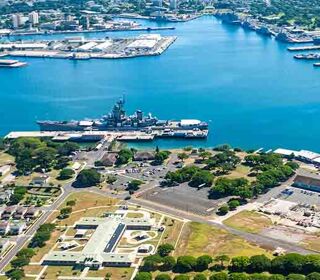
Opinion

As many around the world prepare for the annual festivities, it is maybe important to remember another key moment that occurred in the long history of this incredible month.
On a warm morning in December 1941, a battle would occur which would ultimately decide the fate of those people at the time and the generations since. The 7th December had marked the eventual collision between the aggressive foreign policies and ambitions of imperial Japan, and American avoidance of the storm clouds of war in both Europe and the Pacific regions.
The late 1930's had been markedly different for the two powers, with Japan expanding its territories through the invasion of China, whilst the USA was attempting to recover from the failure of Prohibition and the chaos of economic crisis. If any US politician may have doubted what a potential clash with Japan may have looked like, the horrific war crimes committed by Japanese soldiers during the invasion of China, most notably in the 'Rape of Nanking' gave a foretaste of the context of any future conflict within the Pacific sphere of influence.
The naval base of Pearl Harbour in Hawaii and the US Pacific fleet based there posed a major strategic thorn in the side of further Japanese expansions. As war raged in Europe and with Britain holding its own against the German Luftwaffe, the USA still refused to commit. Even the gigantic invasion of the Soviet Union, in June 1941, could not budge the USA into conflict. In the weeks leading up to the 7th, tensions between Japan and the USA were finally reaching breaking point, with hardliners within the formers own military beginning to dominate national policy, arguing that future expansion would require the complete destruction of the American naval forces in the region.
Why then did the USA not prepare for an impeding attack at Pearl Harbour? Certainly it was true American decryption had cracked the codes used to send messages between Tokyo's foreign ministry and its embassies around the world. However, in a unique twist of fate, the complexity of internal politics within the Japanese state meant that the foreign ministry had simply not been made aware of the impending attack.
Instead the 'Pearl Harbour Plan' was created within the naval ministry and not passed on to other departments, meaning the success of US decoding could not be fully exploited. The attack was simply, strike quickly and without warning using air power to destroy as many ships and aircraft as possible. The damage incurred to the Pacific fleet would render the USA unable to stop a 'blitzkrieg' style land grab by the Japanese forces in the region. With all the ingredients in place, the Japanese fighters and bombers loaded onto aircraft carriers and headed for Hawaii.
At 8:05am on the 7th December, 353 aircraft descended upon the naval base, ready to deliver chaos to those below. As it was a Sunday, many naval personnel were slow to rise, or were recovering from their own celebrations. After only two hours, the scene which was left was one of utter devastation: 2,400 American servicemen were dead, 200 aircraft destroyed and four battleships were sunk with many other vessels badly damaged. Contrary to many depictions by Hollywood, few Japanese aircraft were destroyed during the attack with many flying back to their carriers, assured of success and ultimate victory.
In regards to the overall strategic plan, the attack did allow for the much anticipated land grab to take place with the flag of the setting sun flying over huge swathes of the Pacific by the middle of 1942. At this stage, and as part of the original strategic plan, Japanese forces would consolidate their victories and secure the territory they had already conquered. Unfortunately for them, they suffered from the often recurring illness of war, 'victory disease'. Like gamblers, military forces are intoxicated with the energy of their successes and instead of consolidation, expansion is the only thought. The stretching of supply lines on an already under resourced state, would see the imperial forces pushed to their limits.
With considerable hindsight, the attack would shock the USA into action and the adoption of a much more aggressive foreign policy. On the 8th December, President Roosevelt appeared before congress and announced that the 7th would be a day that would ‘live in infamy', declaring war against the Japanese shortly after. The attack on Pearl Harbour is a clear example of the euphoria of initial gains but ultimately setting on a course of huge long term losses.
The power and almost inexcusable resources of the US command economy would see the country’s output of men and materials completely outstrip Japanese capabilities. As with Hitler's failure to recognise the Soviet Union’s huge resources, the sleeping giant of the USA had finally been awoken in December 1941 and was ready to exact its revenge. The German declaration of war on the USA shortly after the attack further committed the US to a global conflict and, even if its impacts were not felt in the immediate moment, quantity can often overwhelm quality, with the axis powers unable to compete in more important war of resources.
What lessons can be learnt from the events of that fateful day which have not already been discussed at length by historians over the decades since? What is clear is that conflict requires knowing your enemy, not just at that moment but understanding their potential for the future. Secondly, and possibly with an element of controversy, the power of the USA economy and its military are an important tool in global affairs. With current US policy edging towards a climate more in tune with the 1930's, a less involved America within foreign issues will have repercussions on global politics, whether we care to admit it or not.
So when many of us sit down to celebrate the end of the year with the usual food, drink and comforts, it may be worth remembering the huge repercussions of that fateful December morning and in between a glass of mulled wine, imagine the ramifications of war and the counter factual question of what could have been.




